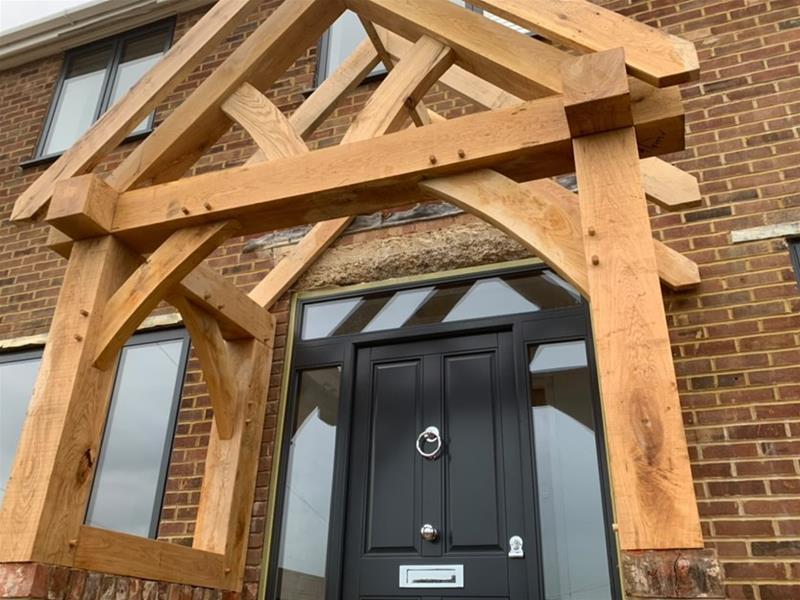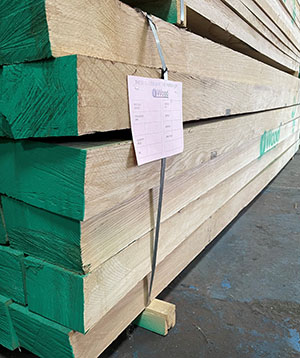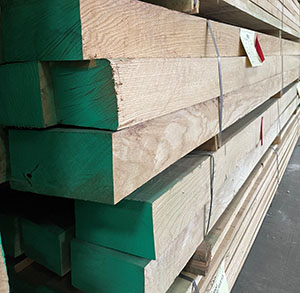Articles: Kiln Dried Oak beams
Can Oak be Kiln Dried
Oak can absolutely be kiln dried, infact, Oak is one of the most popular kiln dried joinery timbers.
If you've done a bit of digging online you've likely seen that in most cases you use fresh sawn oak externally and kiln dried oak internally, with a few exceptions.
 Here is an image of one of our bespoke structures produced from Fresh Sawn European Oak.
Here is an image of one of our bespoke structures produced from Fresh Sawn European Oak.
Which begs the question,
Should the beams for an internal truss or vaulted ceiling be kiln dried oak?
Its a reasonable question but, odds are, the beams you will be using are above 100mm sections and oak cannot be kilned above 100mm, it is simply too thick to dry through completely.
That being said, oak can be kiln dried up to an impressive 100mm.
Due to the large section however it takes alot longer to kiln dry to a low enough moisture content which can make it very expensive.
So if not kiln dried oak beams, what then?
Well, the thing is with oak beams 100mm+ is that because they're dimensionally quite large, the standard few mm of shrinkage expected of fresh sawn oak is much less noticeable than in beams that are say, 50mm x 50mm.
Which means in structures such as trusses or vaulted ceilings, fresh sawn oak is suitable to be used. Although an even more effective method than the expected shrinkage of fresh sawn oak is a product called air-dried oak.
What's the difference between air dried and kiln dried oak?
Similarly to kiln dried oak, the drying process of air dried oak takes out moisture from the beam allowing it to be made more stable and have less moisture movement overtime.You may have picked up on it but, moisture movement in timber dictates how much the timber will change and shrink overtime, it also means initially high in moisture content timber will dry down faster than already dried timber making more significant and prominent appearance changes such as splitting and cracking.
From 13% moisture content kiln dried oak loses moisture at a dramatically lower rate than fresh sawn oak which can be up to 70% moisture content when cut.
Air-dried oak is in the middle at between 25 - 30% moisture content, but you can get some hefty beam sizes whereas kilned you're limited to 100mm.
Can you use Kiln Dried Oak outside?
In short, yes, as long as you completely seal and treat all four sides of the board to prevent water penetration.
As previously mentioned, Kiln Dried oak is dried down to a stable level of moisture content, if left untreated and in contact with moisture it will begin re-absorbing it causing the timber to expand. In turn, this can cause distortion issues across the board
Due to the potential issues of external kiln dried oak it is still important to keep use to a minimum and work with air-dried, fresh sawn oak where you can. In usecases such as cladding and timber fascia's, kiln dried oak is suitable as it is unlikely to be subject to standing or collected water. External Stair treads and External furniture on the other hand, are not suitable as they will be subject to standing water.
Whilst we don't offer the treatments ourselves we do direct our customers to a company called Wood Finishes Direct who are the experts on all wood treatments.
In general prior to installation you would apply a water repellent base coat to the Oak, such as Osmo WR Base coat 4001 to seal the oak. You can then follow that up with a UV protector such as Osmo UV Protection Oil Extra to further preserve the oak and aid in moisture protection.
Below are a few images of Kiln Dried 100mm Oak packs in stock in our warehouse, buy kiln dried oak packs online here









 Main Menu
Main Menu

